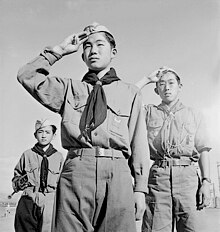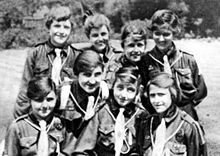
Back طريقة الحركة الكشفية Arabic Mètode Escolta Catalan Skautská výchovná metoda Czech Spejdermetoden Danish Método Scout Spanish Skautlik meetod Estonian Cserkészmódszer Hungarian Metode Kepramukaan ID Metodo scout Italian スカウト教育法 Japanese
This article has multiple issues. Please help improve it or discuss these issues on the talk page. (Learn how and when to remove these template messages)
|
| Scout method | |||
|---|---|---|---|
 World War II era Japanese American Boy Scouts, Heart Mountain Relocation Center, Heart Mountain, Wyoming | |||
 Girl Guides in the United Kingdom, 1918 | |||
|
| |||
The Scout method is the informal educational system used in the Scouting Movement.[1] The aim of Scouting is character training with the goal of helping participants become independent and helpful,[2] and thereby become "healthy, happy, helpful citizens".[3]
The Scout method uses appealing games in the primitive outdoors to generate challenges which a Scout learns to solve by themselves.[2] Through the training and the example of the leader, Scouts are taught independence, leadership, the ambition to learn by themselves, and a moral code with positive goals. According to founder Robert Baden-Powell, the Scout method works naturally and unconsciously: naturally in the way that it follows the natural impulses of the Scout, and unconsciously because the Scout is not aware of the education.
Hands-on orientation provides a practical method of learning and helps the Scout build confidence. Activities and games provide a fun way to develop skills and provide contact with nature and the environment when pursued in an outdoor setting. Scouts learn in small groups to build unity, and a family atmosphere. Developing the characteristics of responsibility, self-reliance, self-confidence, and readiness, the Scouts eventually learn collaboration and leadership skills. An attractive program of varying activities expands a Scout's horizons and bonds the Scout even more to the group.
- ^ "Scout Method". World Organization of the Scout Movement. Archived from the original on 11 March 2015. Retrieved 11 March 2015.
- ^ a b Baden-Powell, Robert. B.-P's Outlook. p. October 1913 – via U. S. Scouting Service Project.
- ^ Baden-Powell, Robert (1926). Scouting for Boys. p. 331.
© MMXXIII Rich X Search. We shall prevail. All rights reserved. Rich X Search